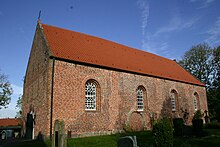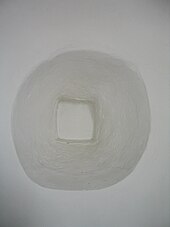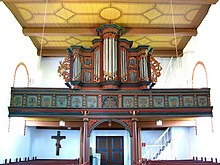Dunum Church

The Evangelical Lutheran Dunumer Church in the main town of Dunum , part of the Esens community in East Friesland , is one of the oldest churches in East Friesland (construction started around 1200). Their furnishings are of supraregional art historical importance.
history
The area around the place has been populated since the Stone Age. It is located on an old sand ridge of the Geest , which here rises up to seven meters above sea level shortly before the descent into the marshy lowlands. Not far away is the Radbodsberg, a burial mound that was used as a burial place for 3,000 years.
The Christianization began in this area probably around the year 850. This is indicated by results of an archaeological dig in 1960 on the "Briller burial ground" in the vicinity of Radbodsbergs in which a change in burial customs was found. The direction of the burial changed from north-south to west-east. According to an old tradition, there is said to have been a wooden church in Dunum as early as the 9th century. In excavations, however, only one wooden house of worship has been found, which is dated to around 1000.
The construction of today's church began between 1200 and 1220. A Romanesque brick building with a retracted semicircular apse was built . The building materials required for this, such as the bricks, were manufactured in the immediate vicinity of the church. The lime for the mortar was also burned from mussel shells (Low German: Schill ) on site. The Church rests on a foundation of granite boulders and stands on an approximately 2 meters high heaped mound . As a Romanesque building, it once had three narrow windows on each long side, which were located directly below the ceiling and let only little light into the interior, and could be entered through portals in the long sides. As the only stone house, this building was for a long time a refuge and meeting place for all residents of the village.
The beginnings of the Reformation in Harlingerland go back to the time after 1525, when Ricardo Hicco began to preach Protestant in Dunum. Many of the old liturgical objects lost their meaning and were used for other purposes.
In 1712 the west gables were renewed. Around 1860 the interior got its present shape and today's eight large round arched windows were broken into to let more light into the interior of the church. The organ and the gallery were moved from the east part of the church to the west gable and the pulpit was moved from the middle of the south wall to the front.
With the help of the “Village Renewal” project, the church, tower and terp were repaired between 1997 and 2001. A renovation of the interior was completed in 2006.
Today the church has about 1000 members. The pastoral office performs additional tasks in the area of the parish of Esens . The trombone choir , founded in 1879, is the oldest in the Harlingerland.
Furnishing
The furnishings of the church are of national art historical importance. The altar table consists of two sandstone slabs that were already provided with five consecration crosses in the pre-Reformation period . Today a crucifix is attached above it , which was created in 1954 by the Bremen sculptor Klaus Bücking from an old mill beam . From the old altar from 1864 a cross has been preserved, which is now attached to the west wall under the organ. The granite basin in the entrance area, which originally served as a holy water basin , also dates from the pre-Reformation period . Other items of equipment from the time when Catholic teaching was still being taught in East Frisia are a piscina (spout for cleaning hands and liturgical utensils), which is located on the right behind the altar, two sacrament niches in the left choir arch and the remains of a hagioscope in the The southeast corner was in the brickwork and has since been closed. Hinrich Johannsen cake baker from Esens donated a pewter jug for the Last Supper in 1700. Outside the church, mediaeval traces of grinding and whetting at the height of the hagioscope bear witness to the Catholic past. Weapons were consecrated here, ceremonially sharpened or blunted, and holy masonry scraped out to take away.
Another special feature of the Dunum Church is the baptismal font , which probably comes from the previous wooden building. Unlike many baptismal fonts in East Friesland in the 13th century made of Bentheim sandstone , it was carved out of granite boulder in the 12th century or around 1200. In the region, a comparable baptismal font is only known from St. Florian in Funnix . A fragment has been preserved in the Church of Westrum . The base of the Dunum baptism consists of four half-columns that merge into four half-figures at the basin, who have folded their hands and whose heads protrude into the edge of the basin.
The pulpit was built in 1769 by carpenter Gerdt Behrens from Esens and painted in 1770 by Claes Röttgers from Wittmund.
In 1954, during a renovation in 1954, two sandstone sarcophagus lids, which were originally in the floor of the choir, were attached to the wall behind the altar. They date from before 1100 and are now hanging across from the pulpit.
organ
The single-manual organ with attached pedal and nine registers was built between 1759 and 1765 by the Wittmund master organ builder Hinrich Just Müller behind a seven-axis prospect . It has largely been preserved and was restored from 1979 to 1981 by Martin Haspelmath , who removed the sub-bass 16 ′ in the pedal , which Johann Diepenbrock added in 1900 . The restored original disposition is (except for the vacant trumpet 8 ′):
|
|
|||||||||||||||||||||||
Bells
As is typical in East Frisia, the distant bell tower contains three bells, of which the smallest bell hanging in the east gable is the oldest. It was cast in 1501 and may come from a closed monastery. It bears the inscription: sancta anna jesus maria johannes anno domini mccccci . The other two bells are from 1935 and 1959.
See also
literature
- Hermann Haiduck: The architecture of the medieval churches in the East Frisian coastal area . 2nd Edition. Ostfriesische Landschaftliche Verlags- und Vertriebs-GmbH, Aurich 2009, ISBN 978-3-940601-05-6 , p. 11, 49, 136, 140 .
- Justin Kroesen, Regnerus Steensma: Churches in East Friesland and their medieval furnishings . Michael Imhof Verlag, Petersberg 2011, ISBN 978-3-86568-159-1 (translation from Dutch).
- Gottfried Kiesow : Architecture Guide East Friesland . Verlag Deutsche Stiftung Denkmalschutz , Bonn 2010, ISBN 978-3-86795-021-3 .
- Michael Salefsky: The Church in Dunum. Dunum [no year] (church leader).
Web links
- Ev.-luth. Haringerland Church District: Dunumer Church
- Genealogy forum: Dunum-Samtgemeinde Esens, Wittmund district
- Monika van Lengen: Esens - Church in Dunum (PDF file)
- Dunum vacation: House of God in Dunum (under "History: Essay")
Individual evidence
- ↑ a b c Church district Haringerland: Dunumer Church . Retrieved September 15, 2019 .
- ↑ a b Genealogy Forum: Dunum- Samtgemeinde Esens, Wittmund district ( Memento from December 18, 2011 in the Internet Archive ), viewed on September 1, 2010.
- ↑ a b c Dunum parish: Church of God in Dunum (under “History: Essay”), viewed on September 1, 2010.
- ↑ a b c Gottfried Kiesow : Architectural Guide Ostfriesland . Verlag Deutsche Stiftung Denkmalschutz, Bonn 2010, ISBN 978-3-86795-021-3 . P. 344 f.
- ↑ a b c d Michael Salefsky: The Church in Dunum.
- ^ Ingeborg Nöldeke: Hidden treasures in East Frisian village churches - hagioscopes, rood screens and sarcophagus lids - overlooked details from the Middle Ages . Isensee Verlag, Oldenburg 2014, ISBN 978-3-7308-1048-4 , p. 74 ff.
- ↑ Kroesen, Steensma: Churches in East Friesland and their medieval furnishings. 2011, p. 213 f.
- ↑ Winfried Topp, Uwe Pape : North German organ builders and their works 2: Peter Tappe / Martin Haspelmath . Pape Verlag, Berlin 2000, ISBN 3-921140-57-9 , p. 147 f .
- ^ Church Dunum, organ , accessed July 27, 2016.
- ^ Bells of the Dunum Church, accessed on September 6, 2018.
Coordinates: 53 ° 35 ′ 44.9 " N , 7 ° 38 ′ 45.1" E




